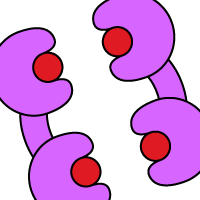iDimerize Reverse Dimerization System (inducible secretion)

The iDimerize Reverse Dimerization System brings the disruption of protein complexes under real-time, small-molecule control. A protein of interest is fused to the DmrD binding domain, and the fusion protein molecules aggregate unless the D/D Solubilizer ligand is present. Plasmid and lentiviral (Lenti-X) vector formats are available.
The iDimerize Reverse Dimerization System brings the disruption of protein complexes under real-time, small-molecule control. A protein of interest is fused to the DmrD binding domain, and the fusion protein molecules aggregate unless the D/D Solubilizer ligand is present. Plasmid and lentiviral (Lenti-X) vector formats are available.
Reverse dimerization: Disrupting protein-protein interactions
The iDimerize Reverse Dimerization System is a “reverse dimerization” system—aggregation is the resting state, and the D/D Solubilizer breaks up protein-protein interactions. Therefore, the iDimerize Reverse Dimerization System complements inducible dimerization, and can be used in analogous ways to create inducible alleles. In principle, most processes that can be brought under dimerizer control can also be controlled in the reverse manner using this kit to turn off a process that is activated by oligomerization.
Inducible secretion
The ability to create large protein aggregates has unique applications. For example, adding a secretory signal sequence to fusion proteins allows them to be reversibly stored as aggregates in the endoplasmic reticulum. The ligand can then be added to induce a rapid pulse of protein secretion from the cells. This method has been used to induce rapid, transient, and tightly regulated secretion of human growth hormone (hGH) and insulin (Rivera et al. 2000).
Protein aggregates can also be used in protein trafficking research. For example, this approach has been used to discover the existence of “mega-vesicles” transporting cargo across the Golgi stack (Volchuk et al. 2000).
D/D Solubilizer ligand
The D/D Solubilizer is a synthetic, cell-permeable ligand that can be used to disrupt dimerization of fusion proteins containing the DmrD domain. The D/D Solubilizer has been tested in vitro and in mice. It is nontoxic. We suggest testing various D/D Solubilizer concentrations within the recommended range (10–500 nM) for different lengths of time (30 minutes to 12+ hours) in order to obtain a complete dose-response profile.
Overview
- Brings the disruption of protein complexes under real-time, small-molecule control
- Plasmid and lentiviral (Lenti-X) vector formats are available
- Previously available from ARIAD as the ARGENT Regulated Secretion/Aggregation Kit
- The D/D Solubilizer performs the same function as the AP21998 ligand, which was previously supplied by ARIAD Pharmaceuticals Inc.; however, it is a different molecule than AP21998
More Information
Applications
- Rapid, reversible changes in the subcellular location, aggregation state, and/or biological activity of engineered proteins in vitro or in vivo
- Rapid induction of protein secretion
- Protein trafficking studies
- Inducible animal models and cell lines
References
Rivera, V. M. et al. Regulation of protein secretion through controlled aggregation in the endoplasmic reticulum. Science 287, 826–30 (2000).
Volchuk, A. et al. Megavesicles Implicated in the Rapid Transport of Intracisternal Aggregates across the Golgi Stack. Cell 102, 335–348 (2000).
Additional product information
Please see the product's Certificate of Analysis for information about storage conditions, product components, and technical specifications. Please see the Kit Components List to determine kit components. Certificates of Analysis and Kit Components Lists are located under the Documents tab.
Takara Bio USA, Inc.
United States/Canada: +1.800.662.2566 • Asia Pacific: +1.650.919.7300 • Europe: +33.(0)1.3904.6880 • Japan: +81.(0)77.565.6999
FOR RESEARCH USE ONLY. NOT FOR USE IN DIAGNOSTIC PROCEDURES. © 2025 Takara Bio Inc. All Rights Reserved. All trademarks are the property of Takara Bio Inc. or its affiliate(s) in the U.S. and/or other countries or their respective owners. Certain trademarks may not be registered in all jurisdictions. Additional product, intellectual property, and restricted use information is available at takarabio.com.







